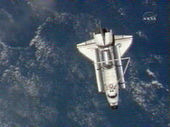
© THE CANADIAN PRESS/Geoff Howe University of Calgary graduate student Ellen Milley poses with fragments of a 10-tonne meteorite she found in a small pond approximately 40 kilometres from Lloydminster, Sask., Friday, Nov. 28, 2008, several days after the space rock created a massive fireball crossing the sky Nov. 20.
Buzzard Coulee, Sask. - The light was fading late Thursday afternoon when the two scientists drove through this pretty little valley just east of the central Saskatchewan-Alberta boundary, but it was still bright enough to spot something on a modest little pond.
"It was a piece of rock frozen into the pond," said University of Calgary graduate student Ellen Milley. "It triggered us to stop."
Geologist Alan Hildebrand knew as soon as he got a close look at it and the other bits of black, dimpled rock nearby that he was looking at emissaries from outer space.
"I know what a meteorite looks like and these are meteorites, very simple," he said.
The fist-sized chunks of black, dimpled rock are small fragments of a 10-tonne meteor that blazed across Prairie skies last week, older than the Earth and from an as-yet-undetermined asteroid belt unimaginably far away.


Comment: While comet impacts may be "much rarer" in our solar system than others, it certainly does not mean they do not strike ours. For a more enlightening and detailed study, read Forget about Global Warming, We are One Step From Extinction!